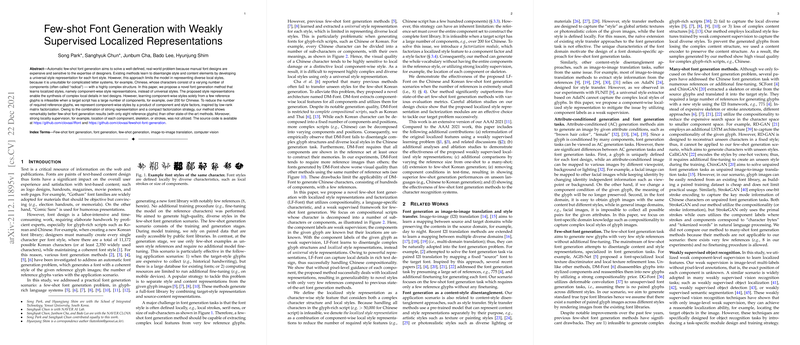Few-shot Font Generation with Weakly Supervised Localized Representations
The paper "Few-shot Font Generation with Weakly Supervised Localized Representations" addresses the challenge of automating font creation, particularly within glyph-rich languages like Chinese and Korean. Traditional font design is labor-intensive, necessitating individual character creation by skilled designers. Most existing approaches attempt to separate style and content elements using universal style representations, which can fall short for languages with more complex structural features. This paper proposes a novel method called LF-Font, which employs localized, component-wise style representations to encapsulate detailed local stylistic nuances in font design, mitigating the limitations of prior techniques.
The proposed technique hinges on the compositional nature of certain language scripts, where characters can be broken down into sub-characters or components. By using localized style representations, LF-Font allows for the synthesis of complex, locally detailed text designs even when only a limited number of reference glyphs (eight in this paper) are available. A significant innovation presented is the use of a factorization module inspired by low-rank matrix factorization, which breaks down component-wise styles into component and style factors. This enables the reconstruction of full vocabularies from incomplete component references, dramatically reducing the necessity for extensive reference data.
The LF-Font method shows marked improvements in generating high-quality fonts over previous state-of-the-art few-shot font generation techniques. The paper provides extensive empirical validations through quantitative metrics such as LPIPS and FID scores, indicating the substantial visual quality enhancements achieved by LF-Font for both new and familiar character sets. It exploits weakly supervised component labels, which are integrated into the learning process without requiring explicit locational annotations for components within the glyphs.
In conclusion, their strategy leverages the inherent language-specific property of compositionality to refine representation learning in the font generation context. This stands to have practical implications in graphic design and digital typography, potentially extending to broader applications in AI-driven content generation. Future explorations might involve adapting this localized representation framework to unpaired datasets or different domains such as attribute-conditioned image generation, hinting at its versatility and robust potential within AI research. The authors provide their source code publicly, facilitating further exploration and potential improvement of their method by the broader research community.
